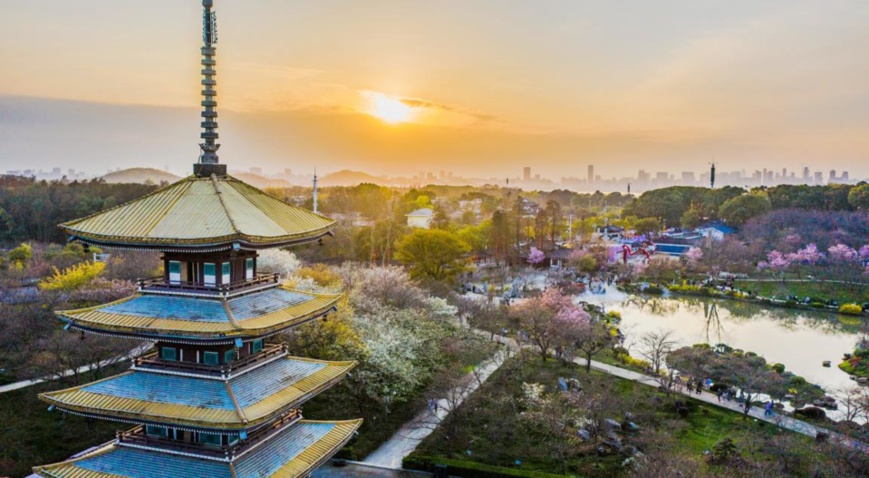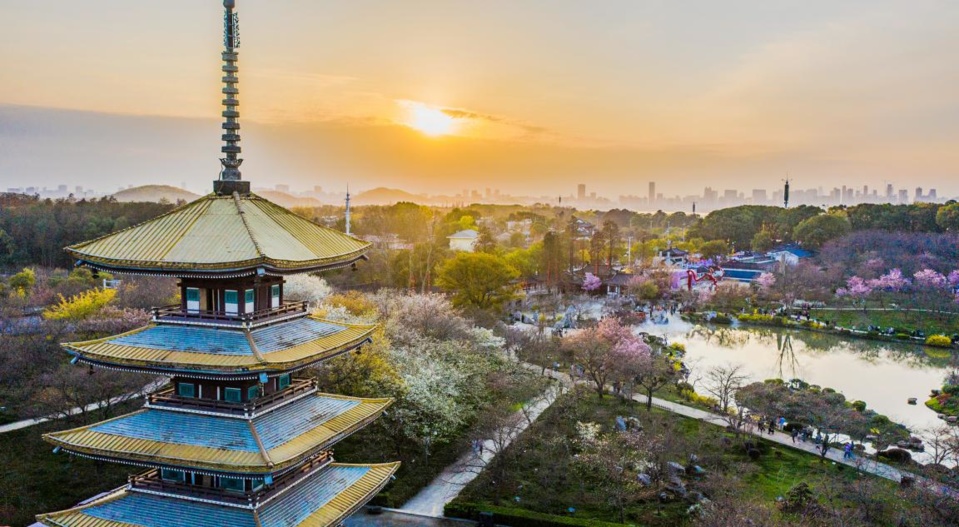By Tian Doudou, Qiang Yuwen, People’s Daily

Photo taken on March 4, 2021, shows a cherry blossom garden in East Lake scenic area in Wuhan, capital of central China’s Hubei province. (Photo by Zhao Guangliang/People’s Daily Online)
As it has recovered from the COVID-19, central China’s Hubei province has arranged more than 40 scenic spots where tourists can enjoy cherry blossoms, ten floral sightseeing tourist routes, and more than 200 artistic performances to thank people around the country, especially medical workers, for their selfless dedication and generous assistance during the COVID-19 fight.
Hubei’s capital city, Wuhan, recently launched cherry blossom viewing activities, including cherry blossom festival and light show, to welcome tourists from across the country.
He Qiaoying, a nurse of Hubei Provincial Hospital of Traditional Chinese Medicine (TCM), was touched by the thoughtful arrangements Wuhan University has made for medical workers to appreciate cherry blossoms when visiting the university on March 9.
Besides a dedicated long red carpeted passage and a signature wall, Wuhan University has also arranged for medical workers creative commemorative badge and one-to-one tour guide service, which shows its appreciation and respect for medical workers.
“I was moved to tears several times in February last year when medical teams from various parts of the country came to help Wuhan. How I wish all of them could return to Wuhan this year and see what the city looks like now with these gorgeous cherry blossoms,” He said emotionally.
During the recently-concluded annual session of the 13th National Committee of the Chinese People’s Political Consultative Conference (CPPCC), China’s top political advisory body, Huang Luqi, a national political advisor and TCM expert recalled his unforgettable experience of leading the first batch of national TCM team to aid Wuhan on the first day of the Chinese Lunar New Year of 2020.
“Our medical workers have taken on the virus bravely by putting themselves in harm’s way, and built the Huoshenshan Hospital, the Leishenshan Hospital, and the Fangcang shelter hospitals, which have played important roles in saving the critical situation,” said Huang, who is also an academician of the Chinese Academy of Engineering.
Today, the city which was once hit hard by the COVID-19 has fully recovered from the pandemic. Over the past year, the Chinese government paid special attention to Wuhan and provided great support for the city in its social and economic recovery and development.
Thanks to the efforts, state-owned enterprises directly under the central government flocked to Wuhan for investment. Eventually, the city made its way back to the list of the top ten cities in China in terms of annual regional gross domestic product (GDP) in 2020 despite the decline in its regional GDP in the first quarter of last year.
As a matter of fact, Wuhan has emerged even stronger from the disaster and enjoyed increased growth momentum since the beginning of this year.
Not long ago, the city kick-started 215 major projects with a combined investment of 330.54 billion yuan (about $50.94 billion).
According to the city’s report on the work of the government in 2021, Wuhan will strive to increase its regional GDP by 10 percent this year. Such an ambitious economic growth target reflects the city’s determination and confidence.
Last year, Hubei province made a total of over 42,000 “Thank You Cards” for medical workers dispatched to the province to assist it in the fight against the COVID-19. With the card, these medical workers are granted the right to visit any of the Grade-A tourist attractions of the province for free for as many times as they want during their whole lifetime.
So far, more than 2,500 medical workers with the card have returned to the province for sightseeing.
Last March, Wuhan University promised in an open letter that it would offer medical workers who have fought against the COVID-19 in Hubei province as well as their family a “green channel” for cherry blossom sightseeing tours of the university to thank them for tiding Hubei over the crisis.
The university also plans exclusive cherry blossom sightseeing tours around its campus for medical workers on March 13 and 14, when medical workers are the only visitors allowed to enter the campus to enjoy cherry blossoms.
Hubei’s capital city, Wuhan, recently launched cherry blossom viewing activities, including cherry blossom festival and light show, to welcome tourists from across the country.
He Qiaoying, a nurse of Hubei Provincial Hospital of Traditional Chinese Medicine (TCM), was touched by the thoughtful arrangements Wuhan University has made for medical workers to appreciate cherry blossoms when visiting the university on March 9.
Besides a dedicated long red carpeted passage and a signature wall, Wuhan University has also arranged for medical workers creative commemorative badge and one-to-one tour guide service, which shows its appreciation and respect for medical workers.
“I was moved to tears several times in February last year when medical teams from various parts of the country came to help Wuhan. How I wish all of them could return to Wuhan this year and see what the city looks like now with these gorgeous cherry blossoms,” He said emotionally.
During the recently-concluded annual session of the 13th National Committee of the Chinese People’s Political Consultative Conference (CPPCC), China’s top political advisory body, Huang Luqi, a national political advisor and TCM expert recalled his unforgettable experience of leading the first batch of national TCM team to aid Wuhan on the first day of the Chinese Lunar New Year of 2020.
“Our medical workers have taken on the virus bravely by putting themselves in harm’s way, and built the Huoshenshan Hospital, the Leishenshan Hospital, and the Fangcang shelter hospitals, which have played important roles in saving the critical situation,” said Huang, who is also an academician of the Chinese Academy of Engineering.
Today, the city which was once hit hard by the COVID-19 has fully recovered from the pandemic. Over the past year, the Chinese government paid special attention to Wuhan and provided great support for the city in its social and economic recovery and development.
Thanks to the efforts, state-owned enterprises directly under the central government flocked to Wuhan for investment. Eventually, the city made its way back to the list of the top ten cities in China in terms of annual regional gross domestic product (GDP) in 2020 despite the decline in its regional GDP in the first quarter of last year.
As a matter of fact, Wuhan has emerged even stronger from the disaster and enjoyed increased growth momentum since the beginning of this year.
Not long ago, the city kick-started 215 major projects with a combined investment of 330.54 billion yuan (about $50.94 billion).
According to the city’s report on the work of the government in 2021, Wuhan will strive to increase its regional GDP by 10 percent this year. Such an ambitious economic growth target reflects the city’s determination and confidence.
Last year, Hubei province made a total of over 42,000 “Thank You Cards” for medical workers dispatched to the province to assist it in the fight against the COVID-19. With the card, these medical workers are granted the right to visit any of the Grade-A tourist attractions of the province for free for as many times as they want during their whole lifetime.
So far, more than 2,500 medical workers with the card have returned to the province for sightseeing.
Last March, Wuhan University promised in an open letter that it would offer medical workers who have fought against the COVID-19 in Hubei province as well as their family a “green channel” for cherry blossom sightseeing tours of the university to thank them for tiding Hubei over the crisis.
The university also plans exclusive cherry blossom sightseeing tours around its campus for medical workers on March 13 and 14, when medical workers are the only visitors allowed to enter the campus to enjoy cherry blossoms.
 Menu
Menu
 China’s Hubei province designs cherry blossom viewing activities to thank medical workers for dedication to COVID-19 fight
China’s Hubei province designs cherry blossom viewing activities to thank medical workers for dedication to COVID-19 fight
















